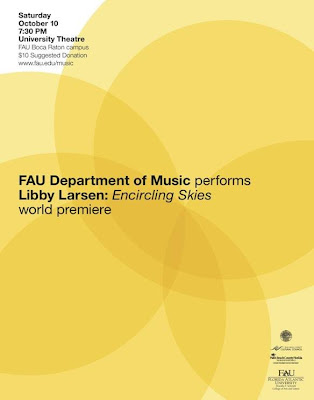By Greg Stepanich
I haven’t seen many full houses at FAU’s University Theatre over the years, but Saturday night’s concert there was exceptional, and not just in that respect.
The overflow crowd had come to hear the world premiere of a new piece by Libby Larsen, one of the country’s best-known composers, whose official Website claims more than 200 works. Larsen, 58, wrapped up the second year of her residency at Florida Atlantic University with a half-hour piece called Encircling Skies, a semi-cantata for chorus, orchestral and wind ensembles, as well as solo instruments including pianos, marimbas, didgeridoo, conch shell and even cellphones.
A hodgepodge setup like that, undertaken to include as many elements of FAU’s music department as possible, poses the peril of lapsing into a gimmicky, incoherent mess. But Larsen is a skilled writer, and she was able to take all those disparate elements and make a piece of music out of them that was not only reflective of South Florida and of FAU, but compelling in itself.
Encircling Skies takes its title from a poem by the African-American poet Paul Laurence Dunbar, one of three poems (one by the 17th-century English poet Robert Herrick, and the other by the contemporary American poet Mark Jarman) heard throughout the work’s continuous seven sections. One of the conceits of the piece has to do with the changing nature of sound, and in its own way is an argument for the pure, acoustic sound of instruments and human lungs over the intrusiveness of electronic sounds of all kinds.
So the piece begins with the chorus simply standing and breathing, audibly, before entering on a soft series of repeated C’s, and then singing the text of Dunbar’s poem. The music here was consistent with Larsen’s general style, which is tonal, warm and melodic, though not without complicated harmonies and difficult melodies; what is striking about her music is how contemporary it is without being angular.
Theatricality was an important part of the work, with that first section ending with a drone from the didgeridoo, played by James Cunningham, and followed by a collage of cellphone sounds (titled The Maenads) assembled by Alejandro Sanchez-Samper and played by graduate students sitting in the audience. Sanchez-Samper said he took the inspiration for his contribution from a story by Julio Cortazar in which a crazed audience at a concert overtakes the performers; it was a witty riposte to the inadvertent electronic heckling that mars so many concerts.
Patricia Fleitas led the FAU Chamber Singers, who sang well throughout the evening, and who had the most compelling music of the work. The choir, which was divided into two sections, one for each side of the stage, remained there for the whole performance while ensembles were switched behind curtains and conductors traded places out front. The FAU Symphony under Laura Joella introduced a jumpier kind of energy in the third section while unseen narrator Dean Peterson declaimed the Herrick poem (Weigh me the fire), after which the Chamber Singers performed the Jarman poem, beginning God like a kiss/God like a welcoming.
To my ears this was the finest music of the piece, a setting that mirrored the poem’s rising sense of ecstasy in the presence of God as the “rush of time,” particularly in the use of the line And God the secret neither one is keeping. The stage switched again for the next section, featuring three pianists — Heather Coltman, Edward Turgeon and Krisztina Kover — and three marimbists — Jason Bloom, Shawn Hagood and Christopher Hand. This sextet, directed by FAU Wind Ensemble conductor Kyle Prescott, played a back-and-forth music of Latin coloring and very tricky rhythms in which a kind of hyper mambo in the pianos alternated with steady, rising tremolando lines in the marimbas.
The Wind Ensemble itself appeared next from behind the curtain (kudos to the students for such a quiet backstage change from orchestra to wind band) with music that began with a quiet muted brass motif and grew in power, leading to the final section, in which the Chamber Singers sang the Herrick poem that had earlier been spoken. Both sections contained music consistent with the choral writing that began the work and consistent with Larsen’s essential style, which is direct, sensitive to text and expressive of it, and tonally friendly.
In the final moments, the theme on which Larsen based much of the music — the hymn tune All Creatures of Our God and King — was heard in the auditorium, played by trumpeter Tim Walters, and the piece faded into silence over a low rumble in the timpani. Overall, Encircling Skies was an effective, interesting piece of music and concert theater, neatly conceived and smartly performed by the combined FAU forces.
Given that it might be difficult to find a didgeridoo player for future performances, Larsen here has written material that could easily be refashioned into a choral work, and one that would be well worth hearing again. Like her well-known version of Elizabeth Barrett Browning’s Sonnets From the Portuguese, this new work has intelligent, persuasive text-setting at its core, and the other parts of the piece, while interesting in themselves, don’t add or detract much from the three poems in a strictly musical sense.
But the special appeal of Libby Larsen is in her enviable ability to take something as usual in our lives as music, rethink it and make it new. The musicians had gathered “to excite the air,” she said in remarks before the performance, and what she has created in this piece is a meditation on the role of sound in concert and in daily life, and in a kindlier way than earlier experimentalists such as John Cage.
Not incidentally, she also brought a major arts happening to Florida Atlantic University, and that is progress of a significant kind that one hopes the school is able to build on in the future.

